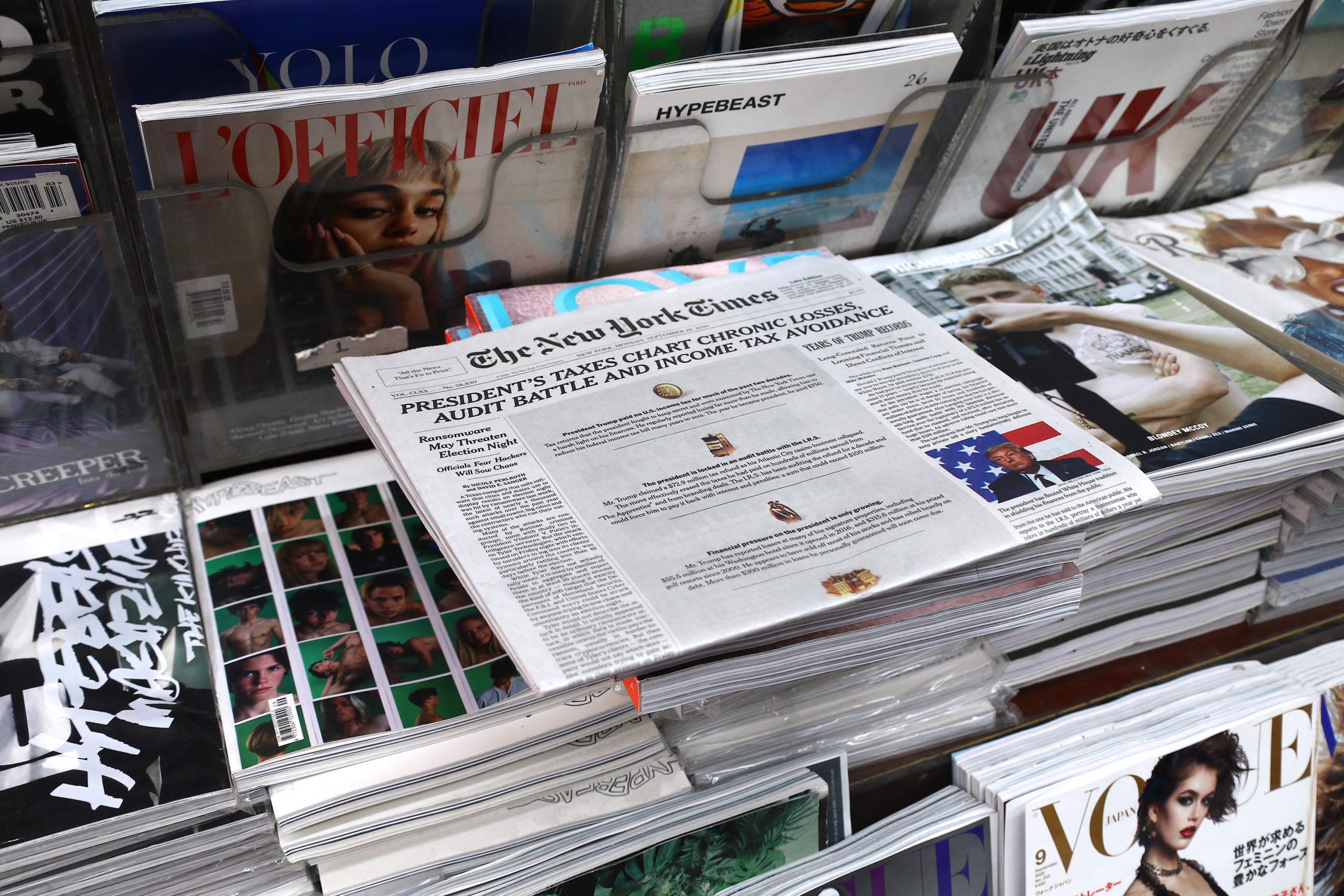Researchers examine the self-serving fiction of ‘objective’ political news

Photo by Charles Guerin/Abaca/Sipa USA(Sipa via AP Images)
Seven years ago, in the wake of the 2016 presidential election, media analysts rushed to explain Donald Trump’s victory. Misinformation was to blame, the theory went, fueled by Russian agents and carried on social networks. But as researchers, we wondered if fascination and fear over “fake news” had led people to underestimate the influence of traditional journalism outlets. After all, mainstream news organizations remain an important part of the media ecosystem—they’re widely read and watched; they help set the agenda, including on social networks. We decided to look at what had been featured on the printed front page of the New York Times in the three months leading up to Election Day. Of a hundred and fifty articles that discussed the campaign, only a handful mentioned policy; the vast majority covered horse race politics or personal scandals. Most strikingly, the Times ran ten front-page stories about Hillary Clinton’s email server. “If voters had wanted to educate themselves on issues,” we concluded, “they would not have learned much from reading the Times.”
Originally published in
COLUMBIA JOURNALISM REVIEW
by David M. Rothschild, Elliot Pickens, Gideon Heltzer, Jenny Wang, and Duncan J. Watts
November 20, 2023
We didn’t suggest that the election coverage in the Times was any worse than what appeared in other major outlets, “so much as it was typical of a broader failure of mainstream journalism.” But we did expect, or at least hope, that in the years that followed, the Times would conduct a critical review of its editorial policies. Was an overwhelming focus on the election as a sporting contest the best way to serve readers? Was obsessive attention to Clinton’s email server really justified in light of the innumerable personal, ethical, and ultimately criminal failings of Trump? It seemed that editors had a responsibility to rethink both the volume of attention paid to certain subjects as well as their framing.In another instance, machine learning tools helped the Greek government to identify incoming COVID-19-infected travelers at nearly double the volume that conventional random tests would have achieved, thereby reducing the spread of the virus within its country. Analytics can also correct long-held misperceptions such as the role of media in shaping public opinion: TV broadcasts are far more pernicious than social media in peddling biased reports, another study using analytics found.
After the 2022 midterms, we checked back in, this time examining the printed front page of the Times and the Washington Post from September 1, 2022, through Election Day that November. As before, we figured the front page mattered disproportionately, in part because articles placed there represent selections that publishers believe are most important to readers—and also because, according to Nielsen data we analyzed, 32 percent of Web-browsing sessions around that period starting at the Times homepage did not lead to other sections or articles; people often stick to what they’re shown first. We added the Post this time around for comparison, to get a sense of whether the Times really was anomalous.
It wasn’t. We found that the Times and the Post shared significant overlap in their domestic politics coverage, offering little insight into policy. Both emphasized the horse race and campaign palace intrigue, stories that functioned more to entertain readers than to educate them on essential differences between political parties. The main point of contrast we found between the two papers was that, while the Post delved more into topics Democrats generally want to discuss—affirmative action, police reform, LGBTQ rights—the Times tended to focus on subjects important to Republicans—China, immigration, and crime.
By the numbers, of four hundred and eight articles on the front page of the Times during the period we analyzed, about half—two hundred nineteen—were about domestic politics. A generous interpretation found that just ten of those stories explained domestic public policy in any detail; only one front-page article in the lead-up to the midterms really leaned into discussion about a policy matter in Congress: Republican efforts to shrink Social Security. Of three hundred and ninety-three front-page articles in the Post, two hundred fifteen were about domestic politics; our research found only four stories that discussed any form of policy. The Post had no front-page stories in the months ahead of the midterms on policies that candidates aimed to bring to the fore or legislation they intended to pursue. Instead, articles speculated about candidates and discussed where voter bases were leaning. (All of the data and analysis supporting this piece can be found here.)
Exit polls indicated that Democrats cared most about abortion and gun policy; crime, inflation, and immigration were top of mind for Republicans. In the Times, Republican-favored topics accounted for thirty-seven articles, while Democratic topics accounted for just seven. In the Post, Republican topics were the focus of twenty articles and Democratic topics accounted for fifteen—a much more balanced showing. In the final days before the election, we noticed that the Times, in particular, hit a drumbeat of fear about the economy—the worries of voters, exploitation by companies, and anxieties related to the Federal Reserve—as well as crime. Data buried within articles occasionally refuted the fear-based premise of a piece. Still, by discussing how much people were concerned about inflation and crime—and reporting in those stories that Republicans benefited from a sense of alarm—the Times suggested that inflation and crime were historically bad (they were not) and that Republicans had solutions to offer (they did not).
Stepping back, if the Times and other major news outlets went through any critical self-reflection after the 2016 election, it doesn’t seem to have affected their coverage. Nor did the leadership of the Times publicly acknowledge any failings. Quite to the contrary, in early 2022, Dean Baquet, the outgoing editor at the time, said in an interview that he didn’t have regrets about the paper’s Clinton-email stories. In the same interview, Baquet acknowledged critiques of his paper’s political coverage but pushed back on them aggressively: “My job is to try to convince my newsroom that they should not be overly influenced by criticism from Twitter,” he said. “If Twitter doesn’t like it, Twitter can jump in the lake.” Baquet—and his successors, and peers at other major outlets—seem to view themselves as exhibiting objective (or pure, independent) judgment. Indeed, A.G. Sulzberger, the chairman of the New York Times Company and publisher of the Times, made exactly that argument in a piece for CJR this spring: “I continue to believe that objectivity—or if the word is simply too much of a distraction, open-minded inquiry—remains a value worth striving for,” he wrote, adding that “independence, the word we use inside the Times, better captures the full breadth of this journalistic approach and its promise to the public at large.”
“I continue to believe that objectivity-or if the word is simply too much of a distraction, open-minded inquiry- remains a value worth striving for .”
— A.G. Sulzberger, chairman of the New York Times Company and publisher of the Times
Regardless of what journalists and owners of major papers proclaim, however, news judgments are inherently subjective. Any claims to objectivity are a convenient fiction. On any given day there are many accurate and arguably newsworthy stories that could appear on a front page. (In our study period, the overlap in front-page-story selection at the Times and the Postwas only about a third.) Which topics editors choose to emphasize is neither accurate nor inaccurate; they simply reflect subjective opinions. Likewise, the way an article is written also involves a series of choices—which facts are highlighted, whose voices are included, which perspectives are given weight. Words such as “objectivity” and “independence”—even “truth”—make for nice rhetoric but are so easily twisted to suit one’s agenda as to be meaningless. After all, Joe Rogan and Tucker Carlson—who, unlike the Times and the Post, don’t operate within the realm of reality—also stake claims to veracity and independence.
What appears in a newspaper is less a reflection of what is happening in the world than what a news organization chooses to tell about what is happening—an indicator of values. Last year, for instance, the Times decided to heavily cover the Russian invasion of Ukraine—understandable, to be sure—but also largely ignored policy implications of the midterm election on the war, as Republicans were threatening to block military aid. Abortion rights were clearly critical to the midterms (with potential impact on laws and judges), whereas crime rates were essentially irrelevant (with no discernible policy hanging in the balance), yet the Times chose to publish twice as many articles on crime (a topic generally favored by Republicans) as on abortion (a topic key to Democrats). The paper also opted to emphasize inflation, rather than job or wage growth, in economic coverage—another choice that catered to Republicans. The Times provided admirably extensive coverage of potential threats to democracy, but in general, midterms coverage didn’t engage much with the dangers posed to the integrity of the election.
The choices made by major publishers are not wrong, per se, for the same reason that one newsroom cannot objectively know how to cover an issue, or how much to cover it: no one can. Still, editorial choices are undeniably choices—and they will weigh heavily on the upcoming presidential race. Outlets can and should maintain a commitment to truth and accuracy. But absent an earnest and transparent assessment of what they choose to emphasize—and what they choose to ignore—their readers will be left misinformed.
AUTHORS
David M. Rothschild

—
Economist Microsoft Research
Elliot Pickens
—
PhD candidate at the University of Wisconsin-Madison
Gideon Heltzer
—
Latin School
Jenny Wang
—
Predoctoral Researcher at Microsoft Research
Duncan J. Watts

—
CSSLab Director, Stevens University Professor, and Penn Integrates Knowledge (PIK) Professor at the University of Pennsylvania
